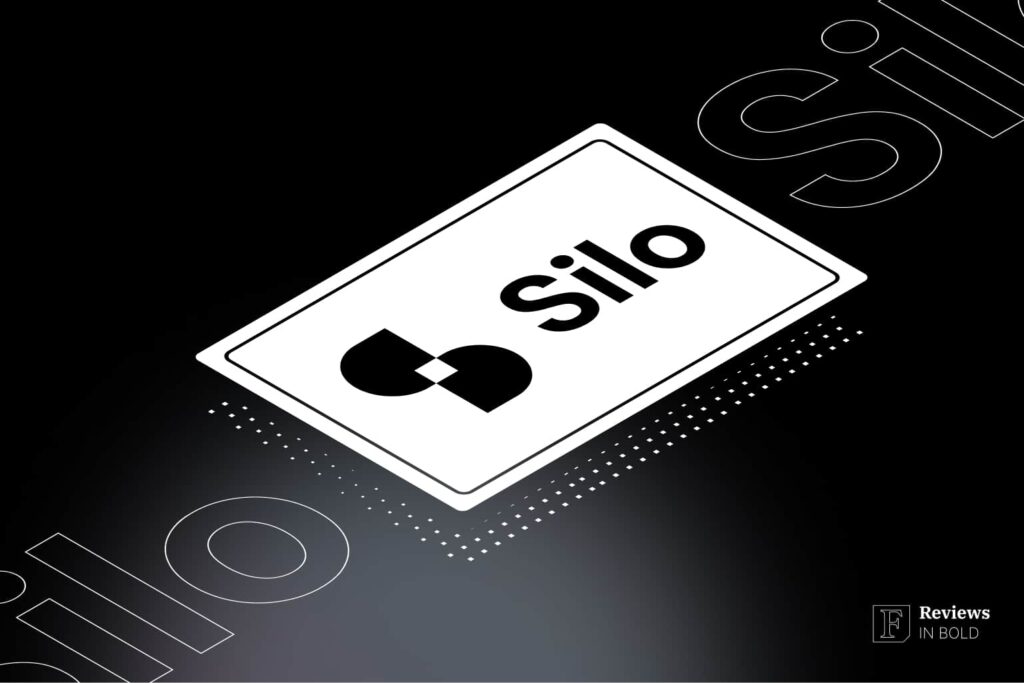Summary: In this review, we examine Silo, a decentralized, noncustodial lending protocol platform. We will go through its key features and offer a step-by-step guide on how to get started with it. We also explore Silo’s benefits, security measures, potential risks, and how it compares to traditional lending protocols.
About Silo
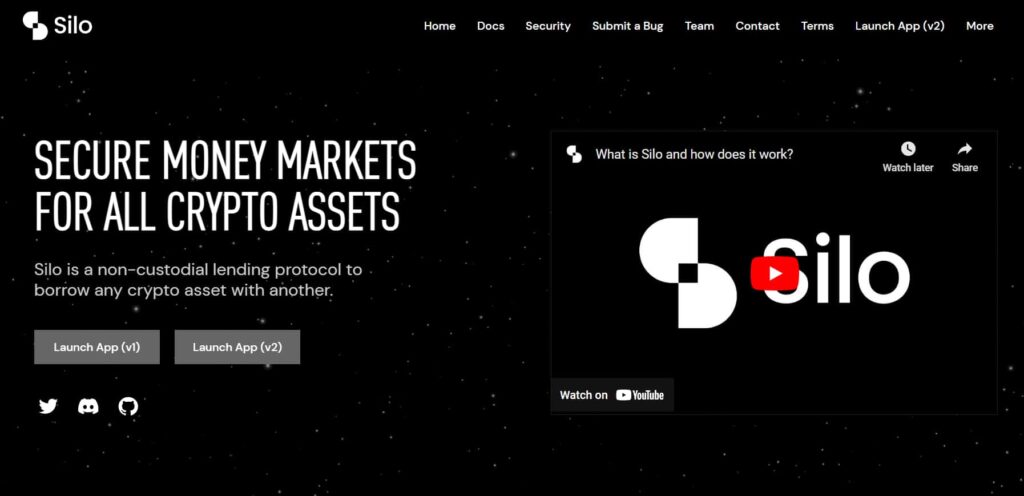
Silo Finance is a decentralized, noncustodial lending protocol designed to enhance security and capital efficiency in DeFi lending.
Unlike traditional platforms that use shared liquidity pools—where risks from one asset can spread to the entire system—Silo isolates each token into its own lending market, known as a Silo. It connects them through a bridge asset like Ethereum (ETH). This approach ensures that each token has its own risk environment while still enabling borrowing and lending across the network.
Silo’s key features
Silo provides a unique approach to decentralized lending, focusing on risk isolation and liquidity efficiency. That said, let’s now get into a detailed breakdown of its core features and highlight each of its strengths and potential limitations.
Isolated risk management
One of Silo’s most distinguishing features is its isolated risk model. Instead of pooling all assets together, each lending market (Silo) consists of only one token plus a bridge asset, typically ETH. This design ensures that risks associated with any single asset remain contained within its respective Silo, preventing protocol-wide failures.
The advantages of this approach include the following:
- If one token in a Silo experiences extreme volatility or a security exploit, it doesn’t impact other Silos or the broader protocol;
- Risk isolation provides a safer lending environment, particularly for assets with uncertain liquidity or security risks.
Still, this feature isn’t without its potential drawbacks, as:
- Users may face liquidity fragmentation since assets are separated into individual Silos rather than pooled together;
- In times of high demand, certain Silos may experience liquidity shortages, making borrowing more expensive.
Efficient liquidity utilization
Silo connects all Silos through a bridge asset, enabling users to deposit one token, borrow ETH, and use it to access other Silos. This model improves liquidity efficiency compared to traditional isolated lending protocols, where separate pools limit usability.
Furthermore, the bridge asset structure allows users to borrow multiple assets without relying on shared liquidity pools. It also reduces exposure to bad debt compared to lending protocols that have shared risk across all assets.
On the flip side, potential drawbacks could revolve around two key points:
- Bridge asset stability: Since all borrowing flows through a bridge asset like ETH, the protocol’s liquidity depends heavily on the bridge asset’s stability and availability;
- Liquidation risks: If ETH experiences severe price fluctuations, users may face unexpected liquidation risks.
Permissionless and scalable
Besides isolated risk management and liquidity utilization, Silo is also a permissionless protocol. This means that any token can be integrated into its system without requiring governance approval. The approach is quite different from traditional lending platforms that only support a limited number of tokens based on governance decisions.
As such, Silo allows developers and projects to add their tokens to Silo without requiring permission, making it highly adaptable. This model also supports a wider range of digital assets compared to lending platforms with stricter listing criteria.
That said, we must note that not all tokens are equally reliable, as some may suffer from poor liquidity, smart contract vulnerabilities, or price manipulation risks. Furthermore, without strict governance approval, the inclusion of low-quality assets could increase the likelihood of bad debt in specific Silos.
Security-focused design
When it comes to Silo security, the protocol has undergone multiple audits to identify potential vulnerabilities. It relies on decentralized price oracles, such as Uniswap V3 and Balancer V2, to determine collateral values.
What this provides users with is the following:
- Regular security audits reduce the chances of smart contract exploits;
- The use of multiple price oracles helps ensure fair asset valuations and protects against market manipulation.
Still, security isn’t without its potential drawbacks. Despite being decentralized, price oracles are not immune to manipulation, as sudden liquidity shifts on Uniswap or Balancer could result in inaccurate price feeds. Also, if an oracle fails or is exploited, borrowers and lenders could suffer significant losses before corrective measures are implemented.
User-friendly interface
Users can easily navigate through different Silos, deposit assets, and manage their positions without extensive technical knowledge. The platform also ensures that both experienced DeFi participants and newcomers can engage with lending and borrowing efficiently, making decentralized finance more accessible.
Despite its user-friendly design, Silo lacks some advanced portfolio tracking tools found in other DeFi platforms. Users must manually monitor their positions or rely on third-party analytics tools to assess risk levels and liquidity conditions within individual Silos. This may require additional effort, especially for those managing multiple positions across different assets.
Transaction costs
Another consideration is transaction costs. Since Silo operates on-chain, users are subject to ETH gas fees, which can become expensive during network congestion. This may impact the cost-effectiveness of smaller transactions, making the platform more suitable for users with larger capital allocations or those willing to navigate fluctuating gas prices.
How does Silo work?
Silo operates as a noncustodial decentralized lending protocol that structures its lending markets differently from traditional DeFi platforms.
Instead of pooling all assets into a shared market, each token has its own isolated lending market (Silo), connected through a bridge asset—typically ETH. This structure allows users to deposit one asset, borrow the bridge asset, and use it to access other Silos without exposing themselves to systemic risks from unrelated assets.
Each Silo consists of only two assets:
- The unique token being used as collateral;
- The bridge asset.
For example, if a user deposits USD Coin (USDC) in a Silo, they can borrow ETH against it. Once they have borrowed ETH, they can use it to enter another Silo and borrow a different token, such as Dai (DAI).
This design ensures that assets remain separated from one another, preventing risk contagion in case of liquidity failures or price volatility in a particular asset.
As mentioned, the platform utilizes decentralized price oracles, such as Uniswap V3 and Balancer V2, to determine asset values and facilitate liquidations when necessary. Hence, borrowers must maintain a sufficient collateral ratio to avoid liquidation, and lenders can deposit assets into Silos to earn interest based on borrowing demand.
While this design enhances security by isolating risks, it also means that the availability of liquidity is dependent on the specific token’s Silo, which may affect borrowing costs and lending opportunities.
Since Silo operates permissionless, any token can be added to the protocol without requiring governance approval. What this does is broaden the range of assets that can be used in decentralized lending.
However, because the protocol does not filter for token quality, users must assess the liquidity and security of individual assets before depositing or borrowing from a specific Silo.
Silo V1 vs. Silo V2
When using Silo’s services, users can choose between two DeFi protocols—Silo V1 and Silo V2. The main differences between these two include:
- Permissionless deployment: Silo V2 is designed to be permissionless, allowing anyone to deploy markets with custom parameters. This means more flexibility and customization compared to V1;
- Hooks system: Silo V2 introduces a Hooks System, which provides an extensible mechanism for interacting with core actions like deposits, withdrawals, borrowing, repayments, and liquidations. This system enhances modularity and allows for seamless interaction with other decentralized systems;
- Liquidation mechanisms: Silo V2 supports partial liquidations and allows for any liquidation mechanism, including partial liquidation. This is an improvement over V1, which has more limited liquidation options;
- ERC-4626 vaults: Both versions use ERC-4626 vaults, but V2 has more advanced features and configurations for these vaults, allowing for individual setups of interest rate models, liquidation thresholds, and other parameters.
How to get started with Silo? Step-by-step process
To get started with Silo, you can follow our step-by-step guide right here.
Step 1: Connect your wallet
To begin using Silo, head over to its official webpage and launch the Silo App by choosing either the V1 or V2 DeFi protocol.

Once you do so, tap on the drop-down menu in the upper right corner and select your deployment choice.
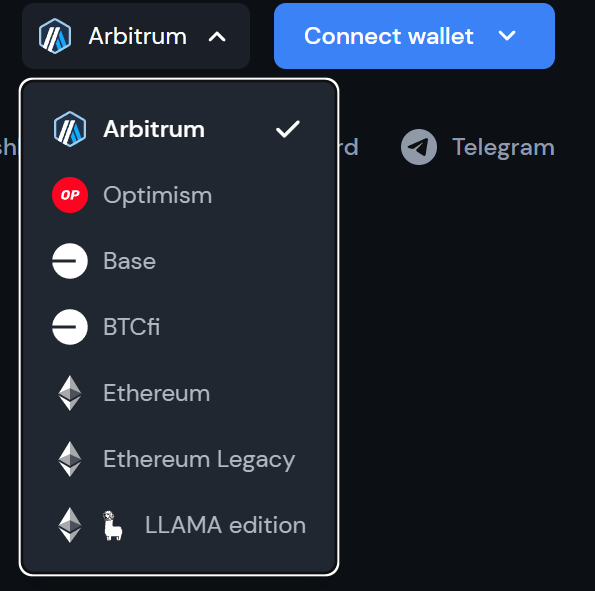
You can connect your wallet by tapping the button right next to the deployment method. After you choose the option, you’ll see the wallets supported by Silo, including MetaMask, Coinbase Wallet, and WalletConnect.
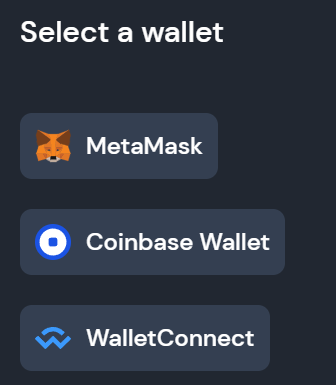
Step 2: Deposit funds (lending)
With a wallet in place, continue by selecting your market. Note that each market supports a base asset and a bridge asset.
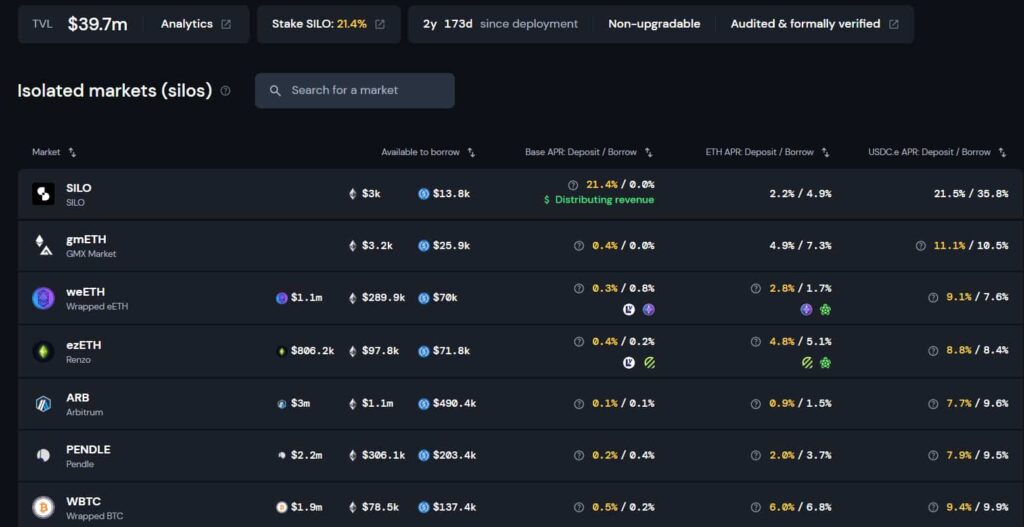
Next up, select the token that you wish to deposit, enter the amount, and tap the Deposit button to complete the first transaction.
Step 3: Monitor and withdraw funds
With everything in place, continue by monitoring your investments and the market conditions in the Dashboard section.
To withdraw your funds, navigate to the Withdraw option, where you can enter the number of tokens that you wish to redeem, or you can simply tap the Max button to withdraw your entire deposit.
Silo tokenomics
Token holders can lock their $SILO tokens to receive veSILO (vote-escrowed SILO), granting them governance rights within the protocol. These rights include proposing and voting on various protocol parameters, such as deploying new markets, adjusting existing market parameters, modifying bridge assets, and altering the DAO’s fee mechanisms.
The protocol has a long-term emission program to incentivize participation. This program allocates approximately 30% of the total token supply (around 300 million SILO tokens) to encourage the use of Silo V2 money markets through the veSILO gauge voting system.
It’s designed to last over 20 years, with emissions distributed to Silo V2 markets and veSILO holders. The allocation of these emissions is determined by veSILO holders through a gauge system, allowing them to vote weekly on distribution weights for proposed markets.
As of now, the maximum supply of $SILO is capped at 1 billion tokens, with a circulating supply of approximately 358.8 million tokens. The current market capitalization stands at around $14.89 million, with each $SILO token priced at approximately $0.0415.
How does Silo compare to competitors?
When it comes to competition, Silo differentiates itself from other DeFi lending protocols by isolating risk within individual lending markets, whereas many competitors rely on shared liquidity pools.
Traditional platforms like Aave and Compound group assets together, which can increase systemic risk if one asset within the pool becomes unstable. In contrast, Silo’s model ensures that issues with one token do not affect the entire protocol, making it a potentially safer option for lenders and borrowers.
Another key distinction is permissionless asset integration. While Aave and Compound require governance approval to add new assets, Silo allows any token to be used within its ecosystem. This feature expands accessibility but also comes with challenges.
Liquidity efficiency is another area where Silo differs. Competitors typically operate shared liquidity pools, which provide deep liquidity for major assets but can expose the protocol to bad debt if a token fails.
Silo mitigates this risk by requiring a bridge asset to facilitate borrowing between Silos, improving security but potentially limiting liquidity in less active Silos.
While Silo’s design enhances risk management and asset flexibility, it does come with trade-offs compared to competitors. Borrowers may face higher borrowing costs or limited liquidity in certain Silos, and the reliance on a bridge asset introduces dependency on ETH price stability.
Additionally, competitors like Aave and Compound have more established risk management frameworks and governance models, which some users may prefer over Silo’s fully permissionless approach.
To put things in perspective, check out our comparison table below:
| Feature | Silo | Competitors (Aave, Compound, etc.) |
| Risk management | Isolated Silos prevent risk from spreading | Shared liquidity pools expose all assets to risk |
| Asset listings | Permissionless—any token can be integrated | Governance-approved listings ensure asset quality |
| Liquidity structure | Uses a bridge asset (ETH), leading to potential liquidity fragmentation | Shared pools provide deep liquidity for major assets |
| Borrowing efficiency | Requires ETH as an intermediary for borrowing different assets | Direct borrowing across a shared pool |
| Market maturity | Newer protocol with decentralized governance | Established platforms with structured governance |
| Security risks | Lower systemic risk but dependent on ETH stability | Higher systemic risk due to pooled assets |
Pros and cons of using Silo
Like any decentralized protocol and platform, Silo comes with both advantages and potential drawbacks. Therefore, let’s take a look at the key pros and cons of using Silo for borrowing and lending.

Pros
- Risk isolation for greater security: Each asset is contained within its own Silo, preventing systemic failures. If one token experiences extreme volatility or security vulnerabilities, it does not affect the entire protocol;
- Flexible and permissionless token support: Unlike traditional lending protocols that require governance approval for new tokens, Silo allows any token to be integrated into the system;
- Efficient liquidity utilization through a bridge asset: Instead of fragmented liquidity pools, Silo connects all lending markets via a bridge asset (typically ETH). This structure enables borrowing across different Silos while keeping risk isolated;
- Non-custodial and decentralized: Users retain full control of their assets at all times. The protocol operates without intermediaries, reducing counterparty risks often present in centralized lending platforms;
- Enhanced security measures: Silo has undergone security audits and utilizes decentralized price oracles such as Uniswap V3 and Balancer V2 to minimize risks related to price manipulation and inaccurate valuations;
- Potential for higher yields: Since Silos are isolated, lending rates can vary significantly between different markets. Users may find higher interest rates in certain Silos compared to shared lending pools.

Cons
- Liquidity fragmentation: Liquidity is not shared across the entire protocol. This can lead to situations where some Silos experience low liquidity, making borrowing more expensive or even impossible if lenders are not supplying sufficient assets;
- Dependency on bridge asset stability: All Silos rely on a bridge asset like ETH to facilitate borrowing across markets. If ETH undergoes rapid price fluctuations, borrowers may face unexpected liquidation risks, and the efficiency of the entire protocol could be affected;
- Potential exposure to low-quality assets: Since Silo allows permissionless integration of any token, there is no inherent quality control on supported assets. Some tokens may have low liquidity, weak security, or be prone to price manipulation, increasing risk for borrowers and lenders;
- Reliance on external price oracles: The protocol depends on decentralized oracles to determine asset valuations. While these oracles reduce centralization risks, they remain vulnerable to price manipulation, especially for tokens with limited liquidity on Uniswap or Balancer;
- Higher gas fees during network congestion: Since Silo operates on-chain, users must pay Ethereum gas fees for transactions. High network congestion can significantly increase borrowing, lending, and liquidation costs, making the protocol less viable for small transactions;
- No built-in portfolio management tools: Unlike some DeFi platforms that offer comprehensive dashboards for tracking risk exposure, Silo requires users to manually monitor their positions or use third-party analytics tools, which can be inconvenient for those managing multiple Silos.
Silo community and support channels
To contact the team behind Silo, you can head over to the official webpage and tap the Contact option in the upper right corner.
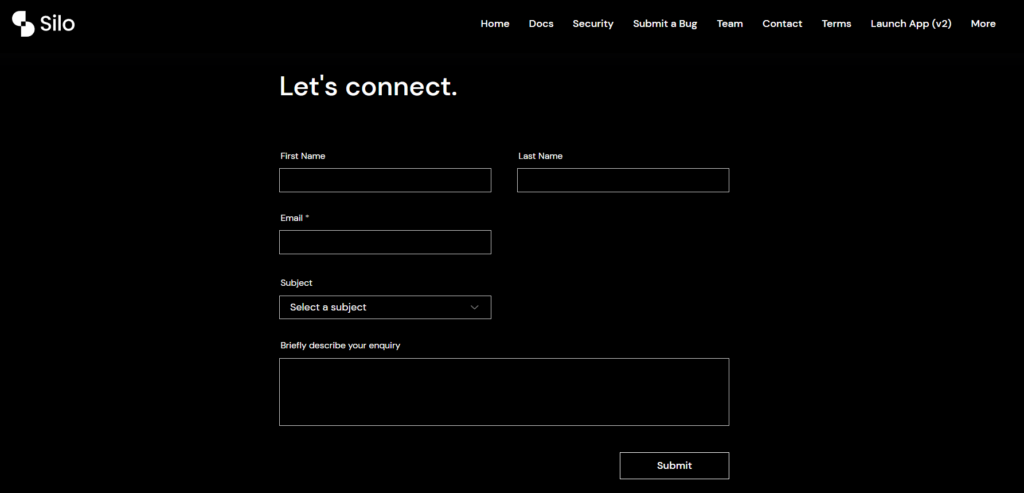
After you enter your personal information and email, you’ll need to choose a subject and describe your inquiry before tapping the Submit button. The team appears to respond promptly. You can also follow what’s up with Silo via other sources too:
- Newsletter: Subscribe to Silo’s newsletter to receive the latest updates via email;
- X (formerly Twitter): Follow Silo Finance on X for the latest news and updates;
- Discord: Ask questions and chat with the team and community.
Other useful links include:
- Claiming $SILO rewards on Hedgy;
- Lending application;
- Submit a bug on Immunefi;
- Silopedia;
- GitHub;
- Medium
- CoinGecko;
- CoinMarketCap;
- Etherscan;
- Arbiscan;
- Telegram Announcements.
The bottom line
Silo Finance offers a unique approach to decentralized lending by isolating risk within individual lending markets while maintaining liquidity efficiency through a bridge asset. This model enhances security by preventing systemic failures but introduces trade-offs, such as potential liquidity fragmentation and reliance on ETH stability.
Compared to traditional DeFi lending platforms, Silo provides greater flexibility in asset listings and a more secure risk structure, but it may not always offer the same liquidity depth or borrowing efficiency. Its permissionless nature allows for broader token support, yet it also means users must carefully assess individual Silos for liquidity and security risks.
Overall, Silo Finance is best suited for users who prioritize risk isolation and decentralized asset integration over deep liquidity and governance-backed risk management.
Disclaimer: The content on this site should not be considered investment advice. Investing is speculative. When investing, your capital is at risk.
FAQs on Silo
What is Silo?
Silo Finance is a noncustodial-decentralized lending protocol that isolates risk by creating separate lending markets (Silos) for each token. Unlike traditional lending platforms that pool all assets together, Silo ensures that risks remain contained within individual Silos while still allowing cross-market borrowing through a bridge asset like Ethereum (ETH).
How does Silo differ from competitor platforms?
Silo Finance differs in risk management and liquidity structure. Aave and Compound use shared liquidity pools, which can expose users to systemic risks if one token becomes unstable. On the other hand, Silo keeps assets separate in isolated Silos, reducing the risk of contagion while maintaining borrowing flexibility through its bridge asset.
What assets can be used on Silo?
Any token can be added to Silo permissionlessly, meaning there is no governance vote required to list new assets. This makes it more inclusive than platforms that limit asset listings but also means users need to evaluate the liquidity and risk of individual tokens before using them as collateral.
What are the main benefits of using Silo Finance?
Aside from each asset being contained in its own Silo and reducing systemic risks, Silo users benefit from permissionless asset support, as any token can be integrated without governance approval. Furthermore, there’s the efficient borrowing model where Users can borrow multiple assets while minimizing risk exposure.
Is Silo Finance safe?
Silo Finance has implemented security measures such as audits and decentralized oracles, which reduce the risk of smart contract failures. However, no DeFi protocol is completely risk-free. Users should conduct their own research, monitor liquidity conditions, and use caution when depositing collateral or borrowing assets.
Can anyone use Silo Finance?
Yes, Silo Finance is permissionless and accessible to anyone with a compatible wallet. However, users must be familiar with ETH gas fees, collateral management, and DeFi lending risks before engaging with the platform.
How do liquidations work on Silo Finance?
If a borrower’s collateral value drops below the required threshold, the protocol automatically liquidates a portion of their assets to repay the loan. Since Silo uses decentralized price oracles, liquidation prices depend on real-time market data. Users should monitor their collateral ratios carefully to avoid liquidation.
What fees does Silo Finance charge?
Silo Finance does not charge direct platform fees, but users must pay ETH gas fees for transactions such as lending, borrowing, and liquidations. These costs vary based on network congestion and the complexity of the transaction.
